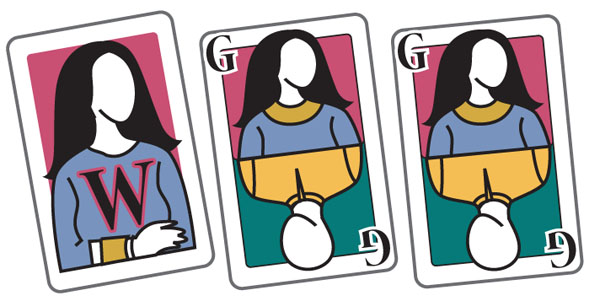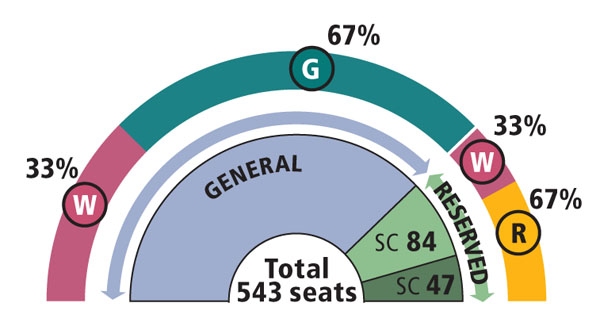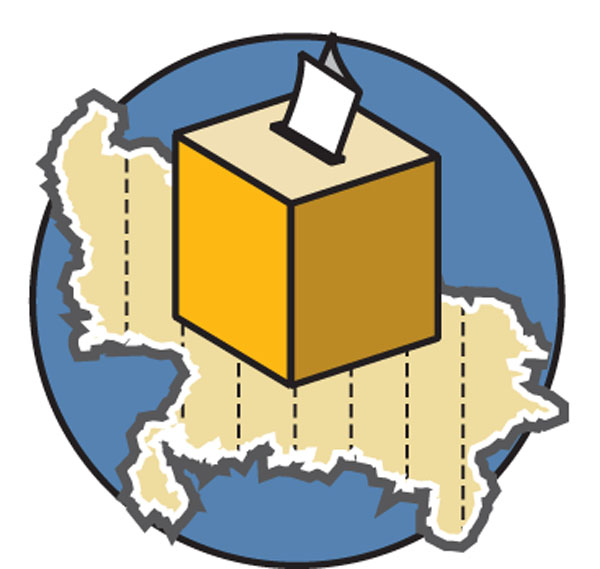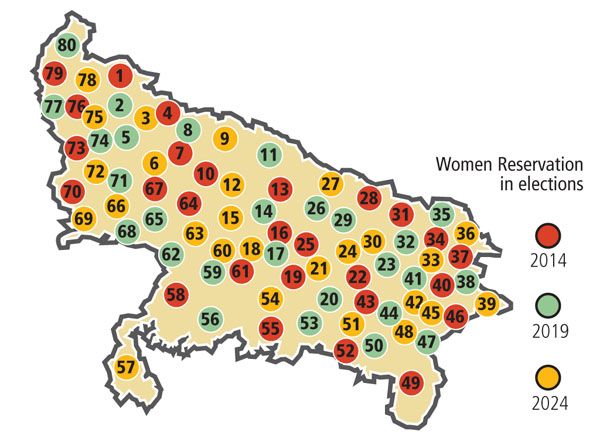
A Quick guide to the Women's Reservation Bill
The bill will pave the way for many fresh candidates into electoral politics
The Womens Reservation Bill seeks to reserve one-third of all seats (both general as well as those already reserved for SCs and STs) for women in the Lok Sabha and the State Legislative Assemblies for a period of 15 years.

 When this passes, two-thirds of all the candidates in any election will become ineligible for the next one. As a result, every election will see two-third of the contestants being knocked over by design: one-third will be knocked over because their seat will become reserved for women and another one-third, all women, from seats which will cease to be reserved.
When this passes, two-thirds of all the candidates in any election will become ineligible for the next one. As a result, every election will see two-third of the contestants being knocked over by design: one-third will be knocked over because their seat will become reserved for women and another one-third, all women, from seats which will cease to be reserved.  The debate will soon shift to the procedure adopted to identify the one-third seats, to be reserved. The method of identification and the sequencing of seats up for reservation are likely to be critical concerns for all political parties since each party has its own strongholds. The Parliament could either lay down the method itself or leave it for some other agency like the Election Commission to finalise the details.
The debate will soon shift to the procedure adopted to identify the one-third seats, to be reserved. The method of identification and the sequencing of seats up for reservation are likely to be critical concerns for all political parties since each party has its own strongholds. The Parliament could either lay down the method itself or leave it for some other agency like the Election Commission to finalise the details. Forbes India tried to find out likely ways in which seats could be reserved. Since only 33 percent of the constituencies can be covered in one election, any method will necessarily involve rotation of seats in order to cover all the seats in the country in the course of three elections.
 The bill will pave the way for many fresh candidates into electoral politics. The current bill was introduced by UPA government in May 2008. However, since the mid 1990s, similar bills have been introduced thrice but could not be passed, due to a lack of consensus among the political parties.
The bill will pave the way for many fresh candidates into electoral politics. The current bill was introduced by UPA government in May 2008. However, since the mid 1990s, similar bills have been introduced thrice but could not be passed, due to a lack of consensus among the political parties. OPTION 1: LOTTERY
What Is to Be Done
Many agree that drawing a lottery could be one way to ensure fairness.
- Make a random selection of 33 percent from the total parliamentary seats in a state to come under reservation in the first elections.
- Then, keeping these aside, one could do another round of lottery to identify the second lot of 33 percent seats that will come under reservation in the succeeding election.
- The leftover 33 percent of the seats will automatically come under reservation in the election after that.
- This will ensure a one-third reservation for women not just across the country but also across each state.
How Will It Be Done
While this method may work for smaller states like Delhi, it could yield a politically unacceptable distribution for bigger states like Uttar Pradesh. “What if, for the sake of argument, bulk of the reserved seats, according to a random selection, fall in western UP,” asks Madhavan. To ensure greater geographical spread, Madhavan suggests “zoning” for the bigger states.
 This means breaking up a state into smaller parts and drawing a similar lottery within each part. For example the 80 constituencies of Uttar Pradesh could be divided into eight parts comprising of 10 constituencies each.
This means breaking up a state into smaller parts and drawing a similar lottery within each part. For example the 80 constituencies of Uttar Pradesh could be divided into eight parts comprising of 10 constituencies each.What Is Left Unaddressed
The hitch is the absence of any logic in choosing constituency. One way to choose the 33 percent constituencies that go for reservation first up, could be by identifying those constituencies which have the highest proportion of women voters. Or constituencies which have historically seen the lowest female representation could be chosen. A simple lottery does not account for any such logic.
OPTION 2: NUMBERING BY ELECTION COMMISSION
However, opposition to women reservations is likely to continue especially at the local levels. So it is not difficult to imagine politicians who get a raw deal in the lottery system protesting even more.
What Is to Be Done
A simpler option may lie in using the innocuous looking numbering that Election Commission uses for identifying constituencies in a Parliamentary election. For example, Bijnore is numbered 1 among the 80 constituencies in Uttar Pradesh while Lucknow is 16 and Saharanpur, almost contiguous to Bijnore is 80th.
 How Is It to Be Done
How Is It to Be DoneStart from one point in the North of the state, move North East, turn clockwise to reach back the North. So there is a sequence of numbering in each state which, if followed, will also take care of geographical distribution of the 33 percent.
What Is Left Unaddressed
This solution suffers from a lack of political logic. Politicians could be suspicious as this method will not involve a political debate on a matter that will potentially affect their electoral fate.
Illustration: Malay Karmakar
(This story appears in the 02 April, 2010 issue of Forbes India. To visit our Archives, click here.)
Post Your Comment
Comments 2
-
 Parliament In India
Parliament In IndiaThe Bill Consist some good clause.which are really beneficial for the women.
on Jun 6, 2013 -
 mohan_reddy_mutyala
mohan_reddy_mutyalaThe great chancellorship for women in this nation. Reservation are charitable for them. No need to chaplet any to any now time is correctly to Implement. Any way good luck to the entire women world.
on Apr 1, 2010














